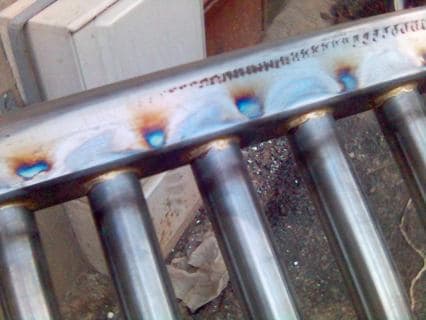
Curated with aloha by
Ted Mooney, P.E. RET

The authoritative public forum
for Metal Finishing 1989-2025

Thread 385/78
Corrosion and metal blackening
2005
Dear All,
We are a tubular radiator manufacturer based in Istanbul.
After welding we usually face with blackish,bluish spots on the profiles, moreover these profiles are going through chrome plating. Prior that we need a treatment that would help to prevent corrosion. So what we are looking for actually is a chemical, either in solution, used as a spray that would help to solve our blackening and corrosion problems. You would see the photograph attached that would help to understand the problem.

Thank you,
Nesligul WagnerManufacturing - Istanbul, Marmara, Turkey
publicly reply to Nesligul Wagner
2005
Hello Mrs. Wagner...
I know your products.I think name of them towel warmers.Also I estimate your problems.Basically,If you get rid of these problems you have to use ultrasonic cleaner system.Or if this system seems expensive you can clean them hot degreasing solvent with manual by sponge or e.t.c.if you have cathodic acid dip baths,your parts's welding zones will be better clean prior to plating.
Good Luck...
- Turkey
publicly reply to Alaattin Tuna
Vapor corrosion inhibitors (VCIs) are designed to be used in a situation such as yours. VCIs form an invisible sacrificial ionic coating on metals. They come in dry, powder or as a liquid, water based coating. There are several ways to apply the VCIs depending on your needs.
Grady Knight- Colville, Washington
2005
publicly reply to Grady Knight
2005
The photo is informative, but also raises some questions. Are you using an oxygen-acetylene torch to braze weld steel or stainless steel with a copper filler metal?
The discoloration isn't usually called corrosion. It is "heat tint," oxidation formed by heating in air. Because it is non-uniform and since dissimilar metals are involved, I suggest using a brush-on descaling paste (nitric and hydrofluoric acids, with ceramic thickener) available from welding suppliers.
The dark discoloration appearing as a row of
∏∏∏HHHNNNSSS may be contamination from a carbon steel fixture. Remove with descaling paste, then avoid in the future by using stainless steel fixtures.
It would be best to avoid the oxidation altogether by switching to a vacuum or inert gas oven brazing process. If not possible, apply a temporary, "stop-off" coating (available from
Heatbath) before brazing to protect the surface. Also, use an inert purge gas to prevent oxidation inside the radiator while brazing. Such oxidation could cause corrosion problems later.
- Goleta, California
Rest in peace, Ken. Thank you for your hard work which the finishing world, and we at finishing.com, continue to benefit from.
publicly reply to Ken Vlach
Q, A, or Comment on THIS thread -or- Start a NEW Thread